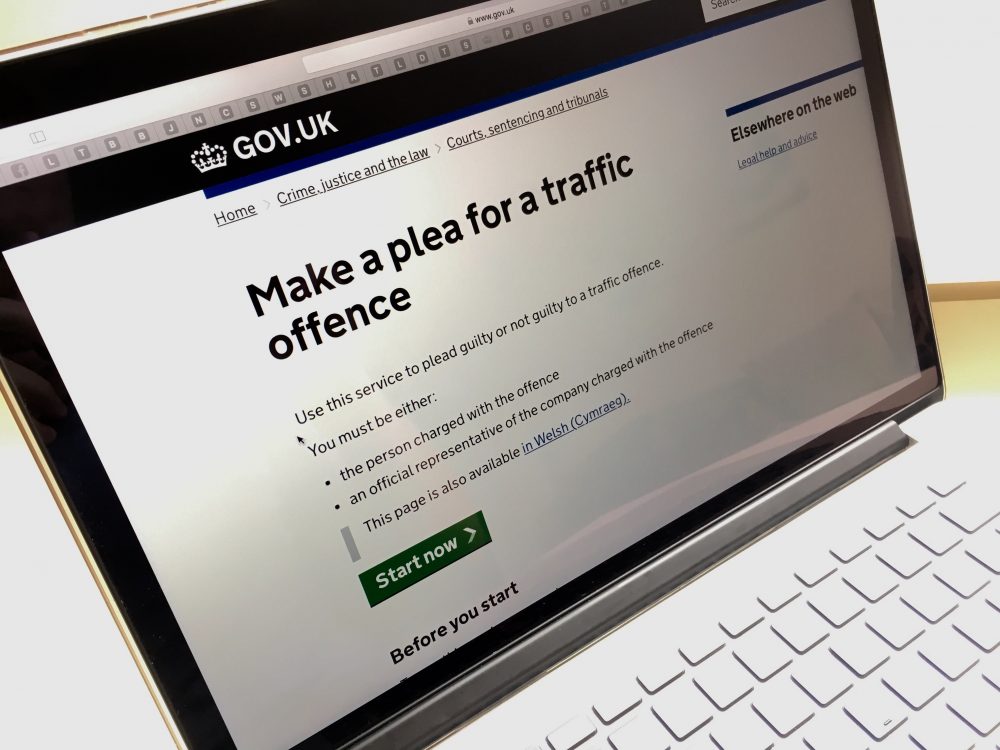[English] - [Cymraeg]
Hi, I’m Katie Dean and I’m the HMCTS Service Manager for the Make a Plea service for traffic offences, which completed national roll out earlier this year.
In this blog post I’ll tell you how all members of the public charged with summary-only, non-imprisonable motoring offences are given the opportunity to submit their plea online, instead of by post.
What is Make a Plea
It’s a public facing digital service which enables defendants to respond online to police prosecutions. Defendants involved in summary non-imprisonable motoring offences such as speeding and having no insurance, can enter their plea online. This results in their case dealt with by a single magistrate under the Single Justice Procedure (SJP).
It’s one of a number of new digital services being delivered by The Criminal Justice System Common Platform Programme, an IT-enabled business change programme. The programme will provide user focused digital services, unifying and transforming the Criminal Justice System; enhancing the criminal justice experience for all users.
Although the option of a paper submission is still available for those who prefer it, using online service from the comfort of a personal space and device is now becoming increasingly popular with public users.

Customers who plead online also receive an early notification of their sentence where a financial imposition has been imposed by the court. The notification provides details on how to pay and local enforcement information, to assist in paying fines. At this stage, the notification does not replace the fine notice which is currently produced.
Roll-out and digital uptake
National rollout is now complete and digital uptake is on the increase.
As of 17 August 2017, magistrates’ courts have already handled more than 52,500 online pleas, with a forecast of 84,000 online pleas by the end of 2017. This is an increase from 58,981 online pleas made in 2016 and 11,898 in 2015.
Lessons learned and planned enhancements
So, what have I learnt about a live digital product? The Online Plea service has a built-in evaluation element, which means users can give feedback after they’ve used the service - and often they do. This is fantastic for me as I have live, up to date, useful insight that is used to improve the service. I review these comments regularly and plan user-led enhancements.
For example, some of the wording in the service has caused confusion with some users, so we have made changes to make it more user-friendly. By reviewing the layout of some of the screens, we’ve also changed and order of some of the questions.
We also get feedback from HMCTS staff and legal teams, this has been invaluable. They found that the way the service worded the question ‘Do you want to come to court to plead guilty?’ was confusing. Customers would pick this option but didn’t really want a court hearing. So we’ve done some redesigning work and are currently testing out some new screens.
This is the great thing about agile working and control our own digital products - if they don’t quite fit or something needs changing, we can review and offer suggestions for change quickly and easily We are no longer ‘stuck’ with a system that we have to work with, we make our service work for us and our customers, which makes for a much simpler customer journey.
I’d be interest in your thoughts on the content of my blog post – please use the comments box at the bottom of this page.
[English] - [Cymraeg]
Mae Cofnodi Ple ar-lein ar gyfer troseddau moduro yn haws byth
Helo, Katie Dean ydw i, Rheolwr Gwasanaeth GLlTEM i’r Gwasanaeth Cofnodi Ple ar-lein ar gyfer troseddau moduro, a gafodd ei gyflwyno’n llawn led led y wlad yn gynharach eleni.
Yn y blog hwn byddaf yn sôn am sut bydd holl aelodau’r cyhoedd sy’n cael eu cyhuddo o droseddau moduro diannod yn unig, ble na ellir rhoi dedfryd o garchar amdanynt, yn cael y cyfle i gofnodi eu ple ar-lein, yn hytrach na thrwy'r post.
Beth yw Cofnodi Ple
Gwasanaeth digidol sydd at ddefnydd y cyhoedd, sy’n galluogi diffynyddion i ymateb ar-lein i erlyniadau gan yr heddlu. Gall diffynyddion sy’n rhan o droseddau moduro diannod ble na ellir rhoi dedfryd o garchar, megis goryrru neu beidio â meddu ar yswiriant, gofnodi eu ple ar-lein. Wedyn bydd un ynad yn delio gyda’r achos dan y Weithdrefn Un Ynad (SJP).
Mae hwn yn un o nifer o wasanaethau digidol sy’n cael eu cyflwyno trwy Raglen Platfform Cyffredin y System Cyfiawnder Troseddol, sef rhaglen newid busnes a gyflwynir trwy Dechnoleg Gwybodaeth. Bydd y rhaglen yn darparu gwasanaeth digidol wedi'i ganolbwyntio ar ddefnyddwyr, gan uno a thrawsnewid y System Cyfiawnder Troseddol; gan wella'r profiad cyfiawnder troseddol i'n holl ddefnyddwyr.
Er bod y dewis i gyflwyno ple ar bapur yn parhau i fod ar gael ar gyfer y rhai hynny sy'n ei ffafrio, mae defnyddio gwasanaeth ar-lein o leoliad personol ar ddyfais eich hun yn dod yn fwy fwy poblogaidd gyda defnyddwyr cyhoeddus.
Gall cwsmeriaid sy’n pledio ar-lein dderbyn hysbysiad cynnar o’u dedfryd ble fo cosb ariannol wedi’i gosod gan y llys. Mae’r hysbysiad yn darparu manylion am sut i dalu a gwybodaeth am orfodaeth leol, i gynorthwyo gyda thalu dirwyon. Ar hyn o bryd, nid yw’r hysbysiad yn cymryd lle'r hysbysiad o ddirwy a gynhyrchir yn bresennol.
Cyflwyno a defnyddio’r gwasanaeth digidol
Mae’r gwasanaeth bellach wedi’i gyflwyno’n genedlaethol ac mae defnydd o’r gwasanaeth digidol yn cynyddu.
Ers 17 Awst 2017, mae'r llysoedd ynadon eisoes wedi delio â dros 52,500 o bledion ar-lein, a rhagwelir bydd 84,000 o bledion ar-lein erbyn diwedd 2017. Mae hyn yn gynnydd o’i gymharu â 58,981 o bledion ar-lein yn 2016, a 11,898 yn 2015.
Gwersi a ddysgwyd a gwelliannau arfaethedig
Felly, beth ydw i wedi’i ddysgu am gynnyrch digidol byw? Mae yna elfen werthuso yn rhan o’r gwasanaeth cofnodi ple ar-lein, sy'n golygu y gall defnyddwyr roi adborth ar ôl defnyddio'r gwasanaeth - a byddant yn gwneud hynny'n aml. Mae hyn yn wych i mi oherwydd mae gen i fewnwelediad byw, cyfredol a defnyddiol sy'n cael ei ddefnyddio i wella'r gwasanaeth. Rwy’n adolygu'r sylwadau hyn yn aml ac yn cynllunio gwelliannau yn seiliedig ar y rhain.
Er enghraifft, roedd geiriad rhai rhannau o’r gwasanaeth wedi drysu rhai defnyddwyr, felly rydym wedi gwneud newidiadau i’w wneud yn haws i’w ddefnyddio. Trwy adolygu gosodiad rhai o’r sgriniau, rydym wedi newid trefn rhai o’r cwestiynau.
Rydym yn cael adborth gan staff GLlTEM a’r timau cyfreithiol hefyd, ac mae hyn wedi bod yn hynod werthfawr. Bu iddynt ddweud bod geiriad y cwestiwn ‘Ydych chi eisiau dod i’r llys i bledio’n euog?’ yn achosi dryswch. Roedd cwsmeriaid yn dewis yr opsiwn hwn ond nid oeddent eisiau gwrandawiad yn y llys. Felly rydym ni wedi gwneud rhywfaint o waith ail-ddylunio ac wrthi’n profi sgriniau newydd.
Dyma’r peth gwych am weithio'n hyblyg a rheoli deunydd digidol ein hunain – os nad ydynt yn gweithio neu os oes angen newid rhywbeth, mae modd i ni ei adolygu a chynnig awgrymiadau i'w newid yn sydyn ac yn hawdd. Nid ydym yn gaeth i'r system mwyach, rydym yn gwneud i'r gwasanaeth weithio i ni ac ein cwsmeriaid, sy'n arwain at daith llawer symlach i'r cwsmer.
Byddwn i’n hoffi clywed eich barn am gynnwys y blog hwn – defnyddiwch y bocs sylwadau ar waelod y dudalen hon os gwelwch yn dda.

4 comments
Comment by Rhiannon Evans posted on
Great development and great take up of the offer. Clearly shows that using online services is as you say becoming increasingly popular.
Comment by David Sarwar posted on
I agree with Rhiannon Evans. Have you got any numbers to reflect the increasing uptake?
Comment by David Sarwar posted on
Thank you for linking my comment to that of Rhiannon Evans. I can read the entries in your blog about the SJP and the Common Platform also.
Comment by Guy Wolfenden posted on
Great progress Katie- and really good to hear that agile techniques are helping you to continually improve the users and service experience.